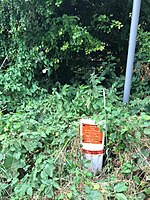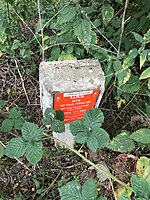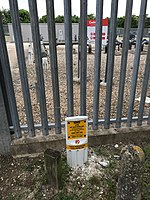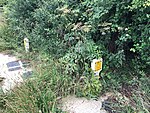Tag:utility=gas
Jump to navigation
Jump to search
 |
| Description |
|---|
| Infrastructure related to gas transmission and distribution towards industries and domestic consumers. |
| Group: man made |
| Used on these elements |
| Useful combination |
| Status: approved |
| Tools for this tag |
The tag utility=gas is added to a feature (such as a marker=*, man_made=street_cabinet or building=service) to specify it is part of infrastructure related to gas transmission or distribution.
Natural and renewable gas are produced, transmitted and distributed along wide and complex Utility networks. This value covers all gas dedicated to heating or cooking including natural gas and other gas fuels for for industrial or domestic usage.
Gas utility usually corresponds to UN International Standard Industrial Classification classes 3520 (Manufacture of gas; distribution of gaseous fuels through mains) or 4930 (Transport via pipeline).
It shouldn't be confused with utility=chemical or utility=oil.
Possible synonyms
Examples
| Photo | Location | Tagging | Note |
|---|---|---|---|

|
France | marker=pedestalutility=gascolour=yellowmaterial=concreteoperator=NaTranref=EZ 20 FI
|
A pedestal indicating the presence of a high pressure gas pipeline buried below |

|
UK | marker=aerialutility=gascolour=red and whitematerial=plastic
|
Standard UK aerial gas marker usually lacks a hat but makes up for this by being 2m tall and quite thick. Although post-shaped, it is tagged as an aerial marker (rather than a post marker), even though it is post-like, for two reasons: (1) it is designed to be visible from the air, and (2) the smaller non-aerial gas markers are already commonly/usually referred to as marker posts in the UK. The "material=plastic" is somewhat redundant as all aerial markers in the UK are plastic. However, since most UK utility markers are either made of concrete or plastic, it does no harm to add this attribute. |

|
UK | marker=postutility=gascolour=redmaterial=plastic
|
National (as opposed to local) gas pipelines in the UK. Plastic markers are usually (though not always) more recent than concrete ones. |

|
UK | marker=postutility=gascolour=redmaterial=concrete
|
National (as opposed to local) gas pipelines in the UK. Concrete markers are usually (though not always) older than plastic ones. |

|
UK | marker=postutility=gascolour=yellowmaterial=plastic
|
Local (as opposed to national) gas pipelines in the UK. Plastic markers are usually (though not always) more recent than concrete ones. |

|
UK | marker=postutility=gascolour=yellowmaterial=concrete
|
Local (as opposed to national) gas pipelines in the UK. Concrete markers are usually (though not always) older than plastic ones. |